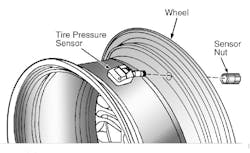SUBJECT VEHICLE: 2008-10 Volvo C30.
RELEARN PROCEDURE? Yes, directions follow.
SPECIAL TOOLS NEEDED? No.
The tire pressure monitoring system (TPMS) on the 2008-10 Volvo C30 is integrated in the central electronics module (CEM) and uses remote receiver module (RRM) or remote keyless entry (RKE), along with four wheel-mounted tire pressure sensors and the driver information module (DIM).
When the vehicle is moving at a speed of 25 mph or faster, the TPMS sensors are activated and transmit their tire pressures and the tire pressure sensor ID once every minute to the vehicle’s RRM or RKE. The RRM or RKE translates and transmit the data to the CEM.
This TPMS system is designed to assist the driver with maintaining the correct tire pressure. It cannot alert the driver when there is a serious problem with the vehicle.
When a low tire pressure is detected, the TPMS will illuminate the tire pressure warning light in the instrument panel, and will display a message on the DIM. The wording of this message is determined by the degree of inflation pressure loss.
To remove an old sensor, follow these steps. NOTE: If a new TPMS sensor or CEM is installed, the CEM must undergo a relearn procedure. The tire should be demounted from the wheel using the tire changer manufacturer’s instructions.
Use the following information to avoid damage during demounting and mounting procedures.
1. Raise the vehicle on a suitable support. Remove the tire/wheel assembly from the vehicle.
2. Remove the union nut and carefully remove the sensor body from the tire pressure valve. See Figure 1.
CAUTION: Only factory-mounted wheels are equipped with TPMS sensors in the valves. If the vehicle is equipped with a temporary spare tire, this tire does not have a TPMS sensor. NOTE: When inflating tires with TPMS valves, press the pump’s mouthpiece straight onto the valve to help avoid bending or otherwise damaging the valve.
To install a new sensor, follow these steps.
1. Place the tire pressure sensor in the wheel hole.
2. Tighten the union screw to 88 in.-lbs. (10 N.m).
3. Install the tire on the wheel. Install the tire/wheel assembly on the vehicle.
4. When a new TPMS sensor is being installed, make sure the TPMS has time to learn the sensor ID.
Ready, set — reset
When the tire pressure warning message has been displayed and the warning light comes on, immediately check the air pressure of all the tires and adjust to the specified pressure listed on the tire label. Make sure the warning light goes off. If the warning light stays on, there is a malfunction in the TPMS. See the appropriate manufacturer’s service information.
If a new TPMS sensor or CEM is installed, the CEM must undergo a relearn procedure. Also, the CEM must learn the new TPMS sensor ID by performing a workshop test or by driving the vehicle.
Driving the vehicle for 10 minutes or more at a speed of 25 mph can program the new TPMS sensor IDs. The low tire pressure warning light will remain illuminated until the CEM has all the new TPMS sensor IDs.
Using the WS test method, the vehicle has to be parked for 15 minutes or more for the CEM to learn the new TPMS sensor IDs. When the CEM has learned all the new TPMS sensor IDs, the scan tool will display “OK” verifying the TPMS sensors are learned and the TPMS is functioning properly.
NOTE: Make sure there are no other learn procedures being performed while the CEM is learning the new TPMS sensors. It is possible to learn the TPMS sensor ID from another vehicle. ■
Information for this column comes from Mitchell 1’s ”Tire Pressure Monitoring Systems Guide” for domestic and import vehicles through 2010. Headquartered in Poway, Calif., Mitchell 1 has provided quality repair information solutions to the automotive industry for more than 80 years. For more information, visit www.mitchell1.com.



